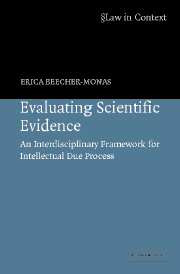Book contents
- Frontmatter
- Contents
- Acknowledgments
- Evaluating Scientific Evidence
- Introduction
- 1 Triers of science
- 2 What is intellectual due process?
- 3 A framework of analysis
- 4 Toxic torts and the causation conundrum
- 5 Criminal identification evidence
- 6 Future dangerousness testimony: The epistemology of prediction
- 7 Barefoot or Daubert? A cognitive perspective on vetting future dangerousness testimony
- 8 Future dangerousness and sexual offenders
- 9 Models of rationality: Evaluating social psychology
- 10 Evaluating battered woman syndrome
- Conclusion
- Index
- The Law in Context Series
10 - Evaluating battered woman syndrome
Published online by Cambridge University Press: 04 December 2009
- Frontmatter
- Contents
- Acknowledgments
- Evaluating Scientific Evidence
- Introduction
- 1 Triers of science
- 2 What is intellectual due process?
- 3 A framework of analysis
- 4 Toxic torts and the causation conundrum
- 5 Criminal identification evidence
- 6 Future dangerousness testimony: The epistemology of prediction
- 7 Barefoot or Daubert? A cognitive perspective on vetting future dangerousness testimony
- 8 Future dangerousness and sexual offenders
- 9 Models of rationality: Evaluating social psychology
- 10 Evaluating battered woman syndrome
- Conclusion
- Index
- The Law in Context Series
Summary
Domestic violence is all too often the hidden fulcrum catapulting litigants into court. Far too often it remains a concealed force. Lawyers may fail to raise domestic violence as an issue, unaware of its impact on their clients' decisions. Judges may refuse to consider domestic violence, finding it irrelevant even when it could explain the reasonableness of a defendant's actions. Courts display an extraordinary reluctance to grapple with its implications. This is especially apparent in the homicide justification of self-defense.
Complicating these issues of admissibility are competing visions of equality under the law. A defining aspect of justice is the requirement of equal treatment under the law. Equality under the law is far from a self-defining concept, however, and much legal debate has focused on its definition, with some arguing for formal equality and others for substantive equality. Evidence law, no less than other legal rules, is subject to the debate about what constitutes equality.
The courts' failure to recognize the impact of domestic violence in making their evidentiary rulings can have drastic effects. Judges frequently misapply evidentiary rules, ignore established precedent, and circumvent criteria for scientific validity. On one hand, circumstances that are normally admissible in male-on-male violence cases become suddenly irrelevant and the context distorted in domestic female-to-male violence cases. On the other hand, the widely adopted solution to the perceived unfairness of the traditional rules when applied to battered women who kill is the admission, by legislative or judicial fiat, of expert battered woman syndrome testimony.
- Type
- Chapter
- Information
- Evaluating Scientific EvidenceAn Interdisciplinary Framework for Intellectual Due Process, pp. 203 - 231Publisher: Cambridge University PressPrint publication year: 2006

